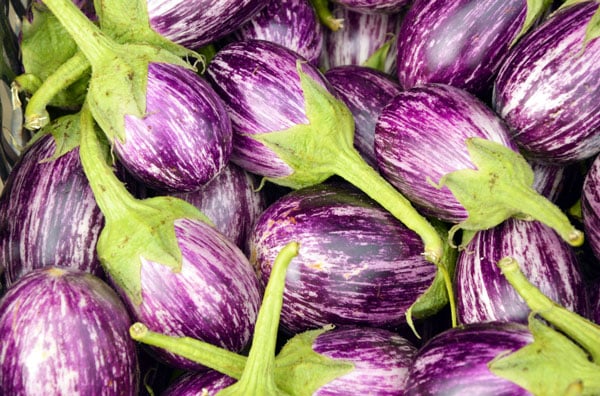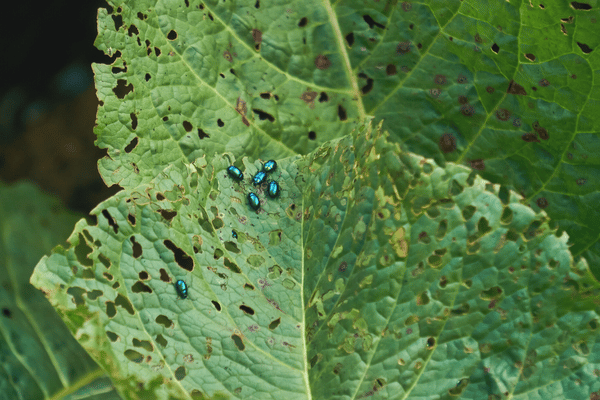This post may include affiliate links.
If you make a purchase, I'll earn a small fee at no extra cost to you.
Spinach is a cool-weather crop that’s packed full of vitamins. With these tips, it’s easy to grow spinach in your garden or in containers and have a great harvest!

Fresh spinach from the garden is so much tastier than the canned or frozen stuff we ate as kids. Many of the varieties these days have a mild flavor and delicious crunch that’s also chock-full of vitamins A, C, iron, and calcium.
Growing Spinach: Quick Start Guide
| Common name(s) | Spinach |
| Scientific name | Spinacia oleracea |
| Sun | Full sun to partial shade |
| Water | Frequent |
| Soil | Well-drained, fertile |
| Hardiness | Cool-weather annual; US zones 2-9 |
| Fertilizer | Every 2 weeks |
| Container size | 2 gallon or larger |
| Pests | Aphids, slugs/snails |
| Diseases | Downy mildew |
| Days to harvest | 28-45 days |
Varieties
There are a few types of spinach–savoy, with curly or crinkled leaves; flat-leaf, which is picked when small for baby spinach; and semi-savoy. The biggest decision to make when growing spinach is whether you want to harvest the leaves when small, for baby spinach, or let them grow to their full size.
Are your seeds still good?
Most vegetable and herb seeds will be viable for many years, but some need to be replaced every year. Get your free Seed Viability Chart here!
My favorite varieties of baby spinach are:
Catalina: Fast growth and bolt-resistance are bred right into Catalina, and its smooth leaves have a mild, nutty flavor with no metallic overtones.
Baby Greens: Can be grown indoors at any time of year; delicious baby spinach leaves add flavor and nutrients to salads, sandwiches, smoothies, and even pesto.
Little Hero: Vigorous and fast-growing, these crisp and smooth leaves have a mild, nutty taste. Perfect for container gardening.
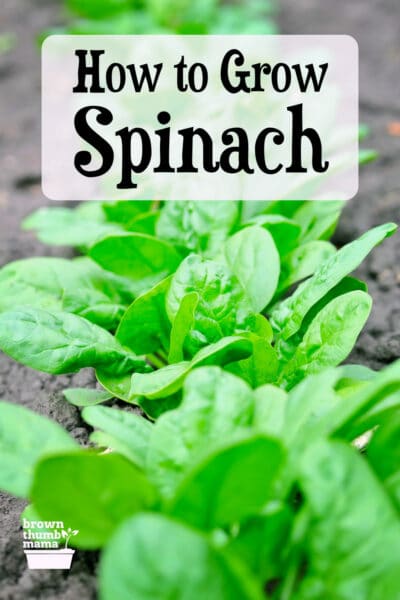
Full size types of spinach:
Bloomsdale: Introduced in the 1800s, Bloomsdale is a vigorous grower, slow to bolt, and has tender, rich-flavored leaves.
Gangbusters: Fast-growing and weather tolerant, with juicy dark green leaves and especially tasty mild sweet flavor.
Matador: great, sweet flavor as a mature plant, can also be enjoyed as a baby green in salad mixes. Productive plants yield smooth, easy-to-clean leaves.
Planting & Spacing
Plant spinach from seed (not transplants) 4-6 weeks before your average last frost date. The soil needs to be between 40-80 degrees for germination. Sow seeds ½ inch deep and at least 1 inch apart, either in rows or broadcast over the soil. A bit of EB Stone Sure Start will help the seeds get started right.
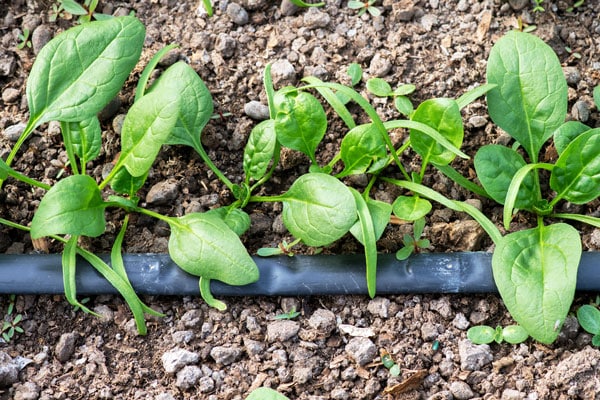
Spinach is great for succession planting, which means starting another crop of the same plant at specific time intervals. This way, you always have a new crop coming in. I like to start a new batch of spinach seeds every 3 weeks, until it gets too hot for the plants to grow.
The seeds will sprout in 5-10 days. The first two leaves will be thin and pointy; the regular leaves appear next. Protect your spinach seedlings from slugs and snails, who can destroy a crop in short order.
Baby spinach doesn’t need to be thinned, but full-sized spinach does. Once the spinach has sprouted and is a few inches tall, thin it so the plants are 5 or 6 inches apart.
I know, thinning is painful–but if the plants are crowded, they’ll be susceptible to fungus, white rust, or other diseases. Be ruthless (and eat the thinnings!).
Growing Spinach in Containers
Many vegetables grow well in containers, and spinach is no exception. Choose a wide, shallow container with good drainage–a 1-gallon pot or larger is fine. Use quality potting mix and be sure to fertilize regularly.
Sun, Water, Soil
Spinach thrives in full sun to partial shade, which means 8 hours of direct sunlight each day. In hot climates, morning sun and afternoon shade will protect the plants from bolting in the heat.
As with lettuce and other leafy greens, spinach needs a lot of water to grow and thrive. Newly-planted seeds and seedlings need to be gently watered each day; mature plants need to be watered every few days.
To test the soil, stick your finger or a wooden chopstick at least two inches deep. If the soil feels damp or sticks to your finger, there’s enough moisture. If your finger comes up dry with no soil sticking to it, it’s time to water. Add natural mulch, which helps conserve water and reduces weeds.
Spinach does best in well-drained, fertile soil with a pH of 6.7 to 7. The best way to improve your soil is to mix in compost or worm castings. It’s easy to make your own compost, which also reduces waste in the kitchen.

Fertilizing
Spinach is a heavy feeder, so I use a diluted fish emulsion with kelp fertilizer every two weeks. If the leaves start to turn yellow, they’re likely deficient in nitrogen. Mix a bit of blood meal into the soil to increase nitrogen levels.
Pests & Diseases
Since spinach grows best in the early spring and fall, most garden pests won’t be around to bother it. You may see some aphids, and there are lots of natural ways to get rid of them.
Watch out for snails and slugs, and dispatch them with these easy tips.
Spinach is also susceptible to downy mildew, which can be avoided by watering at the soil level (not overhead) and by choosing resistant varieties.
Are you a brand new gardener? Not sure what to plant or when to plant it? I can help.
You’ll find lots of great information in my new book, The First-Time Gardener: Container Food Gardening.
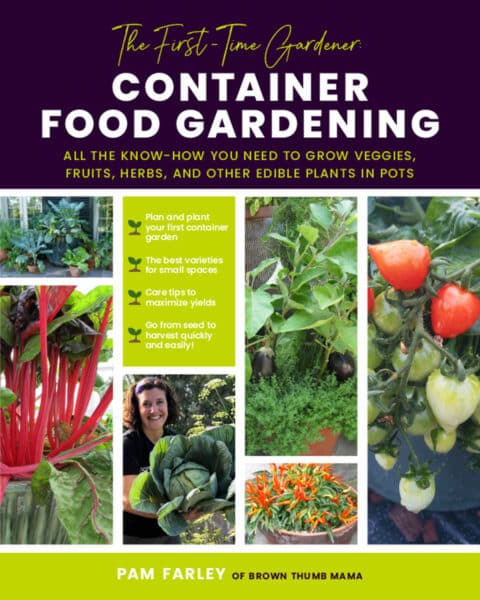
Harvesting
There are two ways to harvest spinach. The first is called cut-and-come-again, which means you snip off the outer leaves and let the inner leaves continue to grow.
The second way is to cut the entire plant, about one inch above the soil. Most of the time, the plant will produce another set of leaves, giving you a second harvest. Combined with succession planting, you’ll have plenty of spinach for all your favorite recipes!
In spring, when the temperature heats up, the plant will send up a seed stalk–this is called bolting. At that point, the leaves will start to taste bitter and I usually pull and compost the plant.
Preserving the Harvest
If you end up with more spinach than you can eat, it’s easy to dry spinach in your dehydrator. This spinach powder can be added to soups, meatballs, or even baked goods. Your kids will get a kick out of eating green pizza!
If you have more spinach than you can eat or dry, share your bounty with your local food bank. Food banks don’t often get donations of fruits and vegetables, and their clients will welcome the fresh food. You can find your local food bank at FeedingAmerica.org.


